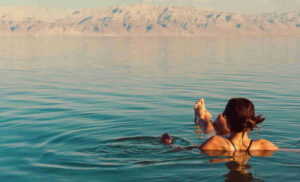We have mentioned it in other posts on this blog, such as this one dedicated to his museum: the Dead Sea is the lowest point on the planet, its shore being located at an altitude of more than -400 meters with respect to the sea. But how is it possible for this to happen? Here we summarize its origin and evolution, which captivates geologists and nature lovers in general due to its uniqueness.
A great rift for the Jordan Valley
The vast majority of the valleys on the Earth’s continental shelf are caused by water erosion, in different ways: river valleys, alluvial valleys or glaciers. And although there is a watercourse in the Jordan Valley, the Jordan River, it has not been primarily responsible for the formation of the valley.
This valley is, in fact, a great rift: that is, it is an elongated tectonic trench, arising from the separation of two tectonic plates. In this case, the African plate and the Arabian plate. This separation took place during the Miocene, millions of years ago (between 23 and 5, approximately). By then, the area was mainly flooded with seawater, thus connecting the Mediterranean Sea, the Red Sea, and the Indian Ocean.
But about a million years ago, the continental shelf rose, causing water to retreat and the land that today separates the Mediterranean from the Red Sea, and which was previously covered in water, emerged. However, not all the sea water disappeared, but animportant part was ‘trapped’ in this tectonic trench, originating the great mass of salt water of the Dead Sea.
We used the term ‘trapped’ because that elevation was not enough to exceed the threshold of 0 meters above sea level. Therefore, the deepest part of the valley was below 0 meters above sea level and the water that flows here or that is dammed has no connection with open water, since around it there is a great natural wall in the form of cliffs: the surrounding plateau has an altitude of several hundred meters above sea level.
The composition of the water of this sea, which is actually an endorheic lake (landlocked) is modified by two aspects: on the one hand, the supply of fresh water from the hydrographic basin of the Jordan River, which rises in Mount Hermon; and on the other, the enormous evaporation that occurs here due to sunshine and high temperatures. This fragile balance is strained by climate change and human use of the waters of the Jordan.
Consequences of negative altitude
Being the lowest point on the planet has several climatic and environmental consequences. We have already mentioned one of them: the basin is endorheic, that is, it does not reach the sea because it is lower than it, which is also contributed by the progressive desertification of the land, since in the past (for example, in biblical times) this region was much more fertile.
Another interesting consequence of its negative altitude is thatultraviolet radiation has less incidence here: UVB rays are weaker here, because the composition of the air has a higher proportion of oxygen due to the higher atmospheric pressure. The result is that the chances of skin burns are lower here, even if prolonged exposure occurs (except on sensitive skin and at midday in summer).
And as far as the water of the Dead Sea is concerned, the consequence is the one already discussed in another post: its extreme salinity, which facilitates effortless flotation and generates sludge widely used by the cosmetics industry, due to its benefits for the skin.



